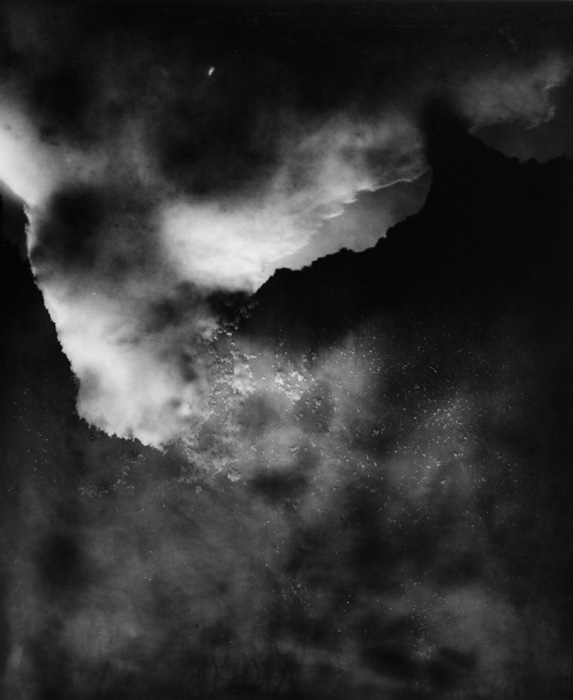Maison de la culture de Côte-des-Neiges, Montréal
12 October – 17 November 2013
By John K. Grande
The origins of camera-less photography go back to the beginnings of photography, with William Henry Fox Talbot’s photogenic drawings, the process for which he described in 1839:
“It is a little bit of magic realized: – of natural magic. You make the powers of nature work for you, and no wonder that your work is well and quickly done. No matter whether the subject be large or small, simple or complicated; whether the flower-branch which you wish to copy contains one blossom, or one thousand; you set the Instrument in action, the allotted time elapses, and you find the picture finished, in every part, and in every minute particular. There is something in this rapidity and perfection of execution, which is very wonderful. But after all, what is Nature, but one great field of wonders past our comprehension?” 1
Many of today’s camera-less photographers, such as Pierre Cordier, Garry Fabian Miller, and Floris Neususs, fall prey to the same object-ness as did Fox Talbot. Other camera-less photographers, such as Susan Derges, approach the romantic, while still others simply re-present aspects of the natural and industrial world with minimal reinterpretation. Michael Flomen’s Snow show is more experimental, just as Man Ray, Alexander Rodchenko, and László Moholy-Nagy were in the early twentieth century. As Flomen comments, “Sometimes I think I am a painter of light. Light is the driving force. The architecture to support the light is all of what we are trying to do. We are really breaking this plane to put all this visual entertainment up, something to trigger your senses.”2
Flomen’s camera-less photo actions are closer to those of his contemporaries Adam Fuss and Chris McCaw; his photograms capture a physical, ever-changing world. The works in Snow are all in black and white. Some have shaped frames and are exhibited in triptychs or diptychs, whereas others are simply-large scale, high-impact, larger-than-life works in industrial-style frames that add a human textural dimension to the photos within. Some are like lunar landscapes – totally abstract and unrecognizable – yet they seize on very real optical, physical effects of light on matter. Mercurial, invisible, intangible, the magic in Flomen’s art is, in his own words, “the material in contact with the elements. There are effects that happen in that photogram-direct contact process that do not happen via a lens.”3
Among the new photograms on view are works that involve crushing sheets of photographic paper so that their exposure to light results in a landscape-like topographic feel. As nature-grams, these abstract works are interactive, low-tech adaptations of our age-old links to the natural world. The effects of snow falling and of snow on the ground, the overviews and the partial views, reveal sensitive light variations, all this in the forum of nature. Some of these works, like Kandinsky’s, are out of this world and with a spiritual dimension. We never know the scale and it doesn’t matter. Crust (1994) has sensitive chaotic patterns, shadings like light drawing. This visuality is about motion, physics, and art.
As new technologies redefine the content and process of imagery in twenty-first-century society, Flomen’s photograms take a different path that involves interactivity just as new technologies do, but in a low-tech, hands-on, physical, and tactile way. As he notes, “Painters have been an influence on the way I work, for instance Yves Klein’s Cosmonogie images where he was throwing paint in the wind, and Jean Dubuffet trying to bring to life textures and get into direct contact with nature’s elements. There is no way you can put materials out into the landscape and have images using a digital process for the moment, unless you start dragging your Epsom printer through the fields.”
Dearfield (1999) looks lunar and moves from pitch darkness in the upper atmospheres to a borderline that arcs with intensity. Spread (2012) is a shaped triptych of photos that have an ironic Pop feel, even though nature is the subject. There are cloud-like apparitions, omissions of light, inclusions of details that appear out of nowhere. Trust (2013) is one large stretched abstraction. Light paints the art into being on photographic paper.
Michael Flomen’s Snow show is as photographic as it is performative and process oriented. His visual encounters with the natural world are less about the material and cerebral, and more about the physics of light, and of space, in nature’s theatre. Like a backwoods Brassai, Flomen captures the abstract potential of snow, and in so doing he changes how we see and conceive of contemporary photography art in the world. It’s all magic, really.
2 Michael Flomen in conversation with John K. Grande, Montreal, 2009. Transcribed by John K. Grande, 2010.
3 Ibid.
John K. Grande’s books include Art Nature Dialogues (SUNY Press, N.Y.) and Dialogues Diversity (Pari Press, Italy). He has curated four editions of Earth Art at the Royal Botanical Gardens and Van Dusen Gardens in Canada and will curate Earth Art 2014 next summer. He co-curated Eco-Art with Peter Selz at the Pori Art Museum, Finland, 2011. Grande’s Interviews with Contemporary World Artists was published in a Hungarian edition in December 2013 and by Quinyan Press in Shanghai, China, in January 2014.


